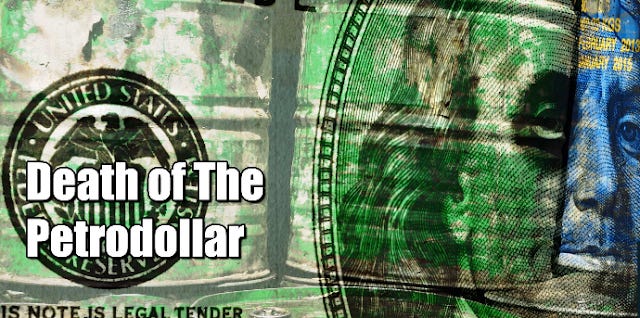Petrodollar, Officially Dead
Almost three years ago I wrote an article entitled, "The Hidden Purpose Behind Trump's Visit to Saudi Arabia-The Dying Petrodollar."
In it I predicted what just occurred this week in the world oil market. I explained that the world economy was on the cusp of major change. Why? Because the petrodollar system was going to crash. Monday morning, it crashed. With the world glutted with oil, no longer do nations solely depend on Saudi-led OPEC oil to run the world economy. Oil is coming out of the ground virtually everywhere, even Ukraine, but that is another story...

The world oil market has become so fragmented, with oil so plentiful, that the Saudis, followed by Russia, decided that their only path forward would be an oil war, their parallel goals to solidify market share, contractual relationships and channels of distribution for themselves, which would allow them to remain in control of a world oil market no longer be ruled by the coercive petrodollar system, but instead by free-market principles, i.e. the Trump effect. Remember, after his election President Trump visited the Saudis before any of our traditional allies, not only to discuss eradicating the world of Islamic terrorism, but to speak constructively about the future of the Saudi-American relationship in a changing world energy market.
At issue here is whether the U.S. dollar can continue as the world’s reserve currency. Since the mid-1970’s the dollar has been the preeminent trading currency around the world. Just imagine owning the franchise for creating and issuing dollars into circulation around the world such that anyone who desires to purchase oil must use the dollars you create and loan at interest into circulation. That would be a pretty good gig, would it not? Well, that is what happens inside the Wall Street Banks. They create currency on their computers, loan them out or even purchase things with them, such as oil futures, stocks, and then reap vast rewards with hardly any risk.
But that system is going away because very soon U.S. dollars will no longer be necessary to purchase oil around the world. Oil is coming out of the ground practically everywhere. The petrodollar will be no more. Trump has known that, which is why Saudi Arabia was a most important first stop on his world tour.
So, what will happen to the value of the dollar once it is no longer the world’s currency?
Good question. When we're talking about the value of the dollar, we talk in terms of the dollar index which reflects the dollar's value relative to the value of other currencies. The prevailing strong dollar has been a result of other nations devaluing their currencies to prop up exports. In response, Trump has been arguing for the Fed to initiate policies that would lower the value of the dollar to prop up our own exports.
If you look at the dollar index over the last month, you will see a significant drop in value relative to other currencies. Trump's purposes seem to be winning out.
Holding all that to the side, however, the dying petrodollar is cause for the value of the U.S. dollar to diminish in the world market. That is because demand for the dollar will diminish at the same time. As nations of the world decide to you use bilateral agreements to trade energy products, using their own currencies, they will no longer need U.S. dollars.
And that is the point. Trump has known that the days of coercing people to use U.S. dollars around the world are numbered. Trump has been working for the last three years to increase the value of the dollar but base it on real market value rather than coercive value. And the way you do that is by building a manufacturing base and creating export markets for valuable products. If buyers want to purchase American products around the world, they will have to possess U.S. dollars to do so.
This entire discussion aligns itself with that of the U.S. trade deficit. A higher and higher trade deficit stimulates vicarious demand for U.S. dollars because those dollars become readily available around the world for various purchasers to use as a trading currency. In other words, the world gets addicted to U.S. dollars.
The problem with that is that to replace all the dollars leaving our shores, the American people go deeper and deeper in debt. That's because all of those replacement dollars have to be borrowed into circulation. The U.S. trade deficit is a debt-creation machine.
By lowering the trade deficit, hopefully to an equilibrium, the need for the U.S. to borrow new dollars into circulation, further indebting the American people, diminishes. That’s because the dollars that leave are replaced automatically with dollars returning.
As that occurs, the U.S. dollar builds intrinsic value rather than an addicted or coercive value. That is where Trump is taking us.
You might recall all the “free trade” conversations while Trump was initiating his famous tariffs on China. Those "quasi-free traders" alleged that Trump was interrupting free trade. They didn't understand, that was not free trade at all. Trump is now, however, building a truly free trade world economic environment. In that kind of environment, the currencies of the world will adjust in value according to the values of the products the various countries can produce, market and sell to the rest of the world. In that world, currency values will be established by the market.



